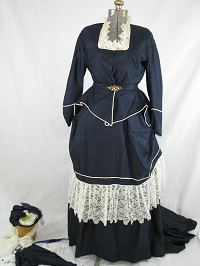1873
The 1870s saw an even greater expansion of the country and American life. Philadelphia staged an exposition to celebrate the Centennial. There they served the first ice cream soda. In women's fashion, extravagance continued. The sewing machine allowed masses of trimming to be applied cheaply. An industrious laborer was as well clad as any millionaire. Fashions did not disappear all of a sudden, but faded gradually through modifications.
In the 1870s, a well-dressed woman wore two skirts, whether she was in a mourning dress or bedecked for a dance. The under skirt was plain and cut to fit the hips in the front. All the fullness is at the center back. Trains were the rule; women often hired sweepers to walk in front of them and sweep the wooden sidewalk. The upper skirt was tied and buttoned up behind her with tapes. The tablier, or apron front, was convenient for hiding defects and correcting mistakes.
Many antique gowns have the side gore cut incorrectly. They should have been sewn with the straight edge to the front. Most of the drudgery was taken out of the actual construction by the sewing machine but much handwork still needed to be done. This bodice is completely lined and boned at the seams. It is tightly fitted with the darts in the front and has a fashionable square neckline. Flounced ruffles, braid, piping, fringe and lace were popular trimmings and were used in abundance. A modification introduced in 1873 was a basque which was an extra short ruffle like skirt. This blue silk gown took 75 hours to make. The hat is small, but with a large bow and flower trim in keeping with the overdone decorating of the day. The white streamers are tied under the hair in the back. A folding parasol, purse and gloves complete the outfit.
In the 1870s, with new back interest, foundations were modified. This gown is supported by a bustle of steel encased in fabric. Tapes are used to adjust the size and shape while a small pad helps hold the skirt high at the waist. The bustle collapses for ease in sitting.
During the 18th and 19th centuries all clothes were made for women whose figures were shaped by the corsets of the period. The black corset hooks up the front and laces up the back. Women slept in their corsets to retain this shape. Although a 16-inch waist was considered fashionable, most of the gowns were not that small. Bloomers were ample and split from front to back.
In 1873, button shoes were the rage. These were fashioned of charcoal and gray suede. Mesh stockings were popular but modesty was carried to the point of wearing flesh colored ones beneath the mesh ones so as not to unduly show the leg.
Click photo for detailed views.


